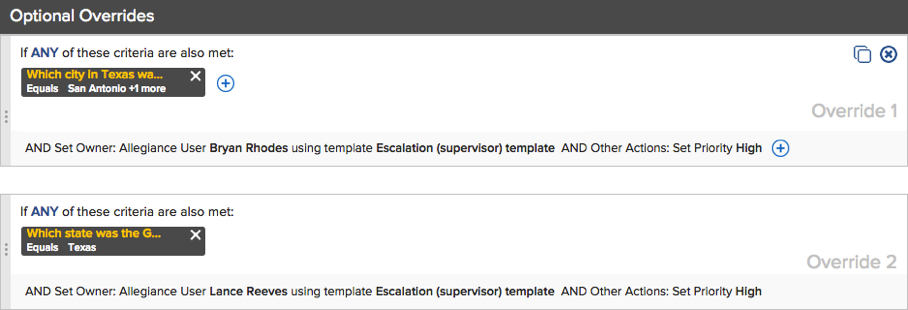
From time to time you may encounter special cases and exceptions that require you to vary the business logic you set up in your basic case creation rule. To do so, you must define an override. Follow the steps in this section to do this.
For our example let's suppose that your organization has decided to pay special attention to the Texas market, and within that market, the Austin and San Antonio areas in particular. Using overrides in your case creation logic can help you accomplish this. Specifically, survey respondents who indicate these places as the location in which their transaction took place will trigger one of the two overrides.
It will look like this:
1. We will create the override with the more narrow definition, the one having to do with Austin and San Antonio, first.
2. We will create the override with the more general definition, the one having to do with Texas overall, second.
It is helpful to point out a few facts about overrides at the beginning:
• Overrides are defined just like the case creation rule.
• Overrides are evaluated in the order in which you define them (Override 1, Override 2, etc.). You can either create them in the desired order, or arrange them as necessary by dragging and dropping them once they are created.
• The actions of the first override whose criteria are met will "override" the actions specified in the case creation trigger.
• Because overrides are evaluated top to bottom, you should place overrides with the most narrow criteria toward the top and overrides with broader criteria toward the bottom.
Step 1
Click on the link in the middle of the page that says Add an override.
Step 2
A new override window appears:

The process of defining a criterion for an override is essentially identical to the process used for defining a case creation criterion. Remember that we said your organization wanted to pay special attention to the Texas market, and to the Austin and San Antonio areas in particular. Since overrides with the most narrow criteria should be first in the list, our first override's criterion will look this:

Here is the logic illustrated by the UI:
The override criterion evaluates to "True" if the answer to the question "Which city in Texas was the General Industries store in that you visited?" equals "San Antonio" or "Austin".
If you wanted to link another criterion to this one, you could add it with the plus button and the appropriate logical connector. We have completed our criterion, however, since it was based simply on the transaction location being in San Antonio or Austin.
Note: As with defining a basic case creation rule, when you create an Override criterion you can create it as either a rule or a group. For instructions on using groups, see here.
Step 3
The next step in creating the override is to specify the action or actions associated with the criterion you just defined. In our hypothetical case, we will want to override the default actions in the following ways:
• Change the case owner from the default owner set in the case creation rule to the account manager assigned to Austin and San Antonio and notify him using the Escalation (supervisor) template;
• Change the priority from the default value of "Medium" to "High".
Notes:
1. Only the actions that you specifically override will change from the defaults specified in the case creation rule; the others will remain the same.
2. If you want to override watcher assignment, each potential type must be overridden separately:
- An Allegiance user Full Access Watcher must be replaced by another Allegiance user Full Access Watcher.
- A Full Access Watcher from a feed file must be replaced by another Full Access Watcher from a feed file.
- An Allegiance user Limited Access Watcher must be replaced by another Allegiance user Limited Access Watcher.
- A Limited Access Watcher from a feed file must be replaced by another Limited Access Watcher from a feed file.
- Watchers from a hierarchy file cannot be overridden; the hierarchy structure will always prevail.
Step 3a
First, click on the Add Action icon underneath the criterion you just defined. The following window opens:

Select the desired action, user, and template from the menus.
Step 3b
Next, click on the plus icon to the right of the action you just defined. Use this action window to set the Priority to "High".
This concludes definition of the override. The interface reflects this:

Note: If one of your actions is reassigning the case to a different owner, the original owner will retain Full Access Watcher rights on it.
Step 4
Recall that we wanted to create the next, more general override to deal with transactions that occurred in Texas overall. To do so, repeat Steps 1-3 with the appropriate values to reflect that circumstance.
Our hypothetical business workflow is represented in the interface like this:
